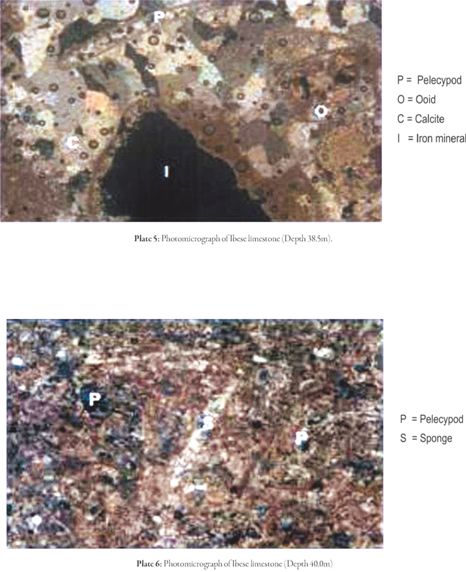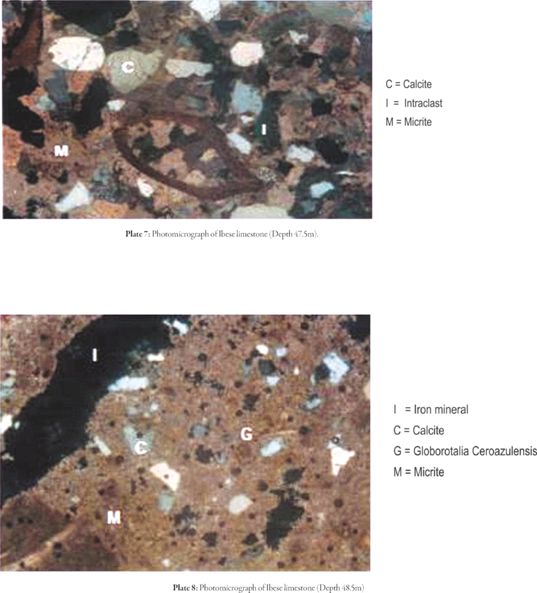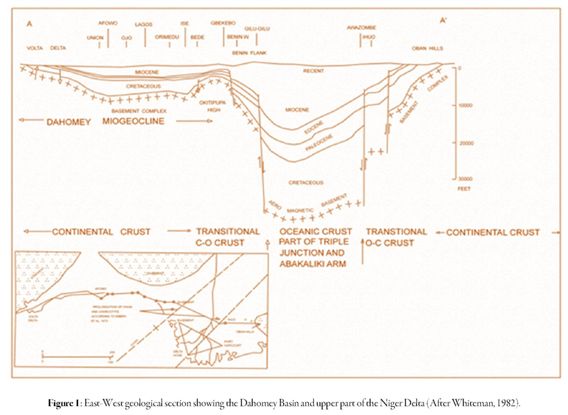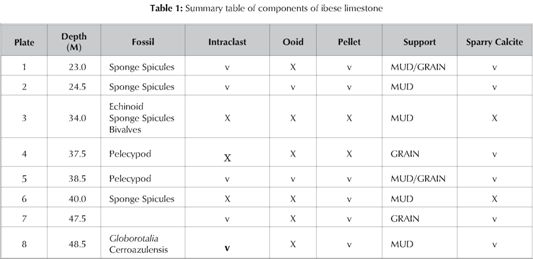Servicios Personalizados
Revista
Articulo
Indicadores
-
 Citado por SciELO
Citado por SciELO -
 Accesos
Accesos
Links relacionados
-
 Citado por Google
Citado por Google -
 Similares en
SciELO
Similares en
SciELO -
 Similares en Google
Similares en Google
Compartir
Earth Sciences Research Journal
versión impresa ISSN 1794-6190
Earth Sci. Res. J. v.14 n.2 Bogotá jul./dic. 2010
Petrographical Study of Ewekoro Carbonate Rocks, in Ibese, South Western Nigeria
1Akinmosin, A., and 2Osinowo, O.O.
1 Department of Geosciences,University of Lagos, Lagos
2 Department of Geology, University of lbadan, lbadan E-mail: waleakinmosin2001@yahoo.com
Record
Manuscript received: 10-05-2010 Accepted for publication: 05-12-2010
ABSTRACT
Limestone deposits can be found in every system of the geologic column since the Precambrian. In classifying this rock, various attempts have been made and notable among them is the classification scheme based on three components: allochems,cements andmatrix. Anotherclassificationdividedlimestoneonthebasis oftextureintograinstone,packstone, mudstone, wackestone and boundstone. Texturally, limestone ranges from fine to coarse grained with aragonite and calcite as the most common minerals. This work was aimed at identifying and describing both the allochemical and orthochemical components ofthe limestone deposits in order to classify and deduce their depositional environment.
Eight core samples of limestone deposits representing the Ewekoro Formation of the Dahomey Basin were studied petrographically.
The result of the analysis carried out on the samples showed that the Ibese limestone is composed of the following allochems: sponges, echinoids, bivalves, coralline algae, and pelecypod which represent the skeletal content and intraclasts, pellets and ooids which represent the non skeletal grains. The orthochemical constituents include the carbonate mud matrix and the sparry calcite cement.
These constituents observed from the slides indicate that the Ibese lime stone belongs totheclass of wackestone and could have been deposited in a quiet and low energy environment.
Keywords: Carbonate, Depositional, Environment, Petrographic, Allochems, Micrite and Fossiliferous.
RESUMEN
Los depósitos de Caliza se pueden encontrar en todo sistema de la columna geológica a partir del Precámbrico. Para su clasificación se han hecho varios intentos y entre ellos es notable el sistema de clasificación basado en alo-químicos, cemento y matriz. Otra forma de clasificación es según la textura. Texturalmente, la caliza va del grano fino a grueso con Aragonito y Calcita como los minerales más comunes. Este trabajo permitió identificar y describir los componentes alo-químicos y ortho-químicos de los depósitos de Caliza con el fin de clasificar y deducir su ambiente de deposición. Se estudiaronpetrográficamenteochomuestras denúcleos dedepósitos de Calizarepresentativos delaFormaciónEwekoro en la Cuenca Dahomey.
Los resultados de los análisis mostraron que la caliza Ibese está conformada por los siguientes alo-químicos: esponjas, equinodermos, moluscos,algas coralinas,ypelecípodos e intraclastos,pellets yooides . Los componentes ortho-químicos incluyen carbonato en la matriz y cemento de calcita espática.
Estos componentes observados en las secciones delgadas indican que la caliza Ibese es de la clase Wackosa y podría haber sido depositado en un ambiente tranquilo y de baja energía.
Palabras clave: carbonato, deposicionales, medio ambiente, petrográfico, aloquímicos, micrita y fosilíferas
Introduction
Approximately 20% of the sedimentary rocks is made up of carbonate rocks especially Limestone and dolomite (Chilingar et al. 1972). The Dahomey Basin (Fig.1) is a marginal pull-apart basin (Klemme, 1975) orMargin sag basin (Kingston et al., 1983), which was initiated during the early Cretaceous separation of African and South American lithospheric plates. The eastern flank of this basin is delineated by the Okitipupa high, while the Western flank extends as far as into Togo and Ghana. The Dahomey Basin contains piles of sediments that have been found to be about 3000m and thickens offshorewards. Studies (geology, stratigraphy, textural and geochemical) on the eastern Dahomey Basin have been undergone by previous authors some of which include Jones and Hockey, 1964;Reyment, 1965; OmatsolaandAdegoke, 1981 CokerandEjedawe, 1983; Billman, 1992; Elueze and Nton, 2004 and Akinmosin et al, 2005.
In classifying limestone, various attempts have been made, notable among them are the classification scheme of Folk (1959,1962) which was based on three components: allochems, matrix and cements. The classification of Dunham, 1962 divides limestone on the basis of texture into grainstone, packstone, mudstone, wackestone and boundstone.
This work is aimed at identifying and describing both the allochemical and orthochemical components of Ibese limestone deposits based on petrographic studies and to deduce the depositional environment.
Stratigraphy
The area of study covers Ibese, Ogun State, Southwestern Nigeria. It is within the Eastern Dahomey Basin of Nigeria. (Fig. 2). Ibese lies at the southern edge of the Ewekoro depression and is overlooked by the escarpment capped by the Ilaro Formation which forms a prominent feature in the area. Ibese quarry is located along Ilaro-Idiroko road and it lies between latitudes 6 9 N and7 Nandlongitudes 3 Eand3 3 E. Ibese quarry is operated by the Dangote cement company.
The reviewed work of Omatsola and Adegoke (1981) on the Cretaceous stratigraphy of the Dahomey Basin has recognized three formations belonging to the Abeokuta Group. These are: the Ise Formation, consisting essentially of continental sands, grits and siltstones, overlying the basement complex. Neocomian to Albian age has been assigned to this formation. Overlying the Ise Formation is the Afowo Formation, which consists of course to medium- grained sandstones with variable interbeds of shales, siltstones and clay. The sediments of this formation were deposited in a transitional to marginal marine environment Turonian to Maastritchtian age has been assigned to this formation. The Araromi Formation consists essentially of sand, overlain by dark-grey shales and interbedded limestone and marls occasional lignite bands. The formation conformably overlies the Afowo Formation and Maastrichtian to Paleocene age has been assigned (Omatsola and Adegoke, 1981).
Overlying the Abeokuta Group conformably is the Imo group, which comprises of shale,limestone and marls. The two-lithosratigraphic units under this group are: Ewekoro Formation and Akinbo Formation. Adegoke (1977) described the formation as consisting of shaly limestone about12.5m thick which tends to be sandy and divided it into three microfacies. Ogbe (1972) further modified this and proposed a fourth unit. It is Paleocene in age and associated with shallow marine environment due to abundance of coralline algae, gastropods, pelecypods, echinoid fragments and other skeletal debris. Akinbo Formation lies on the Ewekoro Formation and it comprises of shale, glauconitic rock bank, and gritty sand to pure grey and with little clay. Lenses of limestone from Ewekoro Formation grades literally into the Akinbo shale very close to the base. The base is characterized by the presence ofa glauconitic rock. The age ofthe formation is Paleocene to Eocene.
Overlying the Imo group is the Oshoshun Formation. It is a sequence of mostly pale greenish-grey laminated phosphatic marls, light grey white-purple clay with interbeds of sandstones. It also consists of claystone underlain by argillaceous limestone of phosphatic and glauconitic materials in the lower part of the formation. Eocene age has been assigned to this formation (Agagu, 1985). The sedimentation of the Oshoshun Formation was followed by a regression, which deposited the sandstone unit of Ilaro Formation (Kogbe, 1976). The sequence represents mainly coarse sandy estuarine deltaic and continental beds, which show rapid lateral facies change.
The coastal plain sands are the youngest sedimentary unit in the eastern Dahomey Basin. It probably overlay the Ilaro Formation unconformably, but convincing evidence as to this is lacking (Jones and Hockey, 1964). It consists of soft, poorly sorted clayey sand and pebbly sands. The age is from Oligocene to Recent.
Methodology
Samples used for this work are core samples retrieved from a well in Ibese. Eight Samples were selected at an average vertical interval of 1.5m. Part of the field work included thorough optical examination of the samples. Afterwards, the selected samples were clearly labeled and kept in sample bags for laboratory analysis.
Prepared slides from the collected samples were closely examined under plane polarized light.The stage of the microscope was rotated continuously to attain different views of the slides. Photomicrographs of each slide were taken under crossed nicols and comparison was made with carbonate photomicrograph catalogue to ascertain the compositional features.
Results and discussion Lithology
The limestone samples from Ibese quarry are medium grained with colour ranging from light brown to cream. Dark brown stains were also observed on some of the exposed samples which is an indication of oxidation of the iron content. The samples were observed to be highly fossiliferous.
Petrographic Description
Allochemical constituents, carbonate mud matrix (micrite) and sparry calcite cement are the major components of carbonate rocks, Folk (1959, 1962). The petrographic description of Ibese limestone was based on these three parameters. The term "allochem" is applied to carbonate grains greater than 0.062mm Rich, 1964.
Discussion
Allochems
The non skeletal grains identified from the petrological study are intraclast,pelletsandooidswhiletheskeletalgrainsrepresentthefossilcontent.
Skeletal Grains (Fossil Content)
For the identification of the fossil content of the Ibese limestone, the following points were noted: shape, internal micro-structure and presence of spines or pores. The following were identified with varying depth: Sponges, echinoderms, pelecypods, bivalves, coralline algae andforaminifera Globorotalia cerroazulensis.
Sponges
The sponge spicules are composed of silica or calcite. Sponges were identified in Plates 1 and 6 at depths 23m and 40m respectively. They serve as source of silica for the formation of chert nodule and the silicification of the limestone.
Echinoderms
It was observed that sparite cement crystal had grown syntaxially around the echinoderm fragment identified in the lbese limestone deposit. (See Plate 3a).
Bivalves
Bivalve shells identified in the deposit consisted of several layers of specific internal microstructure composed of micron-sized crystallites. (See Plate 3b).
Non Skeletal Grains
Intraclasts
These are fragments that have been reworked within the area of deposition thereby forming new sediment. Sizes of identified intraclasts ranged from sand size to pebble or boulder size. Sub-angular or subrounded types were rare and some of them were identified to possess irregular protuberances. Some have complex internal structure and contain fossils, pellets, quartz silt as seen in Plates 1,2,5,7 and 8.
Pellets
These are rounded, spherical to elliptical or ovoid aggregates of microcrystalline calcite ooze which are devoid of any internal structure. They show a uniformity of shape and size (See Plate 6).
Ooids
These are particles that show either radical or concentric structure (Plates 2 and 5). Ooid typically form in agitated waters.
Carbonate Mud Matrix (Micrite)
It is considered as forming very largely by rather rapid chemical or biochemical precipitation in sea water settling to the bottom and at times undergoingsomelaterdriftingbyweakcurrents. Micritewas identifiedinmost of the samples studied (Plates 2,3,4,7 and 8)
SparryCalcite Cement
Thistypeofcalcitegenerallyformsgrains orcrystals10 micronsormorein diameter and is distinguished from macrocrystalline calcite by it's clarity as well as coarsercrystalsize. Large coarsegrains ofsparrycalcite whichwere white and grey in colour were observed to be dominant in Plates 1 and 7.
Environmental Interpretation
This is based on the fossil content and the dominant support ofthe Ibese limestone (Table 1). The fossil contents include sponges, echinoids, bivalves, coralline algae, pelecypod which are typical ofan open shelfenvironment. The presence of echinoid indicates deeper waters. The dominant support is mud and muddiness is generally a property ofrocks deposited in quiet water and a low energy environment. The absence of shell fragments is indicative of this.
Conclusion
Petrographic studies ofIbese limestone deposit have shown that the rock is highlyfossiliferous withthe identifiedfossils indicatingdeposition in an open shelfenvironment. Moreover, thelimestonedepositwasequallyobservedto be principallymudsupportedwhichis indicativeofrocks depositedin quiet water and a low energy environment.
From the aforementioned textural characteristics, Ibese limestone deposits can be classified as Wackestone according to Dunham, 1962.
References
Adegoke O. S. (1977): Stratigraphy and Paleontology of the Ewekoro Formation (Paleocene) of South western Nig. Bulletin American Paleontologist, Vol. 71, No 295, 375pp. [ Links ]
Agagu O.A (1985): A Geological Guide Bituminous Sediments in South Western Nigeria. Unpublished Report, Department of Geology University of Ibadan. [ Links ]
Akinmosin A., Odewande A.A., and Akintola A.I.(2005): GeochemicalComposition and Textural Features of some Carbonate Rocks in Parts of Southwestern Nigeria. Ife Journa lof Science, Vol.7, num.1. [ Links ]
Billman H.G. (1992): Offshore Stratigraphy and Paleontology of Dahomey Embayment, West Africa. Nigerian Association of Petroleum Explorationist Bulletin, Vol.7, No.2 pp.121-130. [ Links ]
Chilingar, G.V., Mannon R.W.and H.R. Riecke (1972): Oiland Gas production from Carbonate Rocks Ed by G.Larson and G.V. Chilingarpp 408. Elsevier, New York. [ Links ]
Coker S.L. and Ejedawe J.E.(1983): Hydrocarbon Source Potential of Cretaceous Rock of Okitipupa Uplift, Nigeria Journal of Mining and Geology; Vol. 20 pp 168-169. [ Links ]
Dunham R.J. (1962): Classification ofCarbonate Rocks According to Depositional Texture, In: Classification of Carbonate Rocks (Ed.ByW.E.Ham), pp 108-201. [ Links ]
Elueze, A.A., andNton, M.E.(2004).Organic geochemical app raisal of lime stones and shales in part of eastern Dahomey Basin, South western Nigeria. Journal of MinningandGeology, vol.40 (1), pp.29-40. [ Links ]
Folk R.L (1959): Practical Petrographic Classification of Limestone. Bulletin of American Association of Petroleum Geologist, Vol.43, pp1-38. [ Links ]
Folk R.L (1962): Spectral Subdivision of lime stonetypes In: Classification of Carborate Rocks (Ed. By W.E Ham), 1, pp 62-82 [ Links ]
Jones M.A. & Hockey R.O. (1964): The Geology of Part of South Western Nigeria. Nigeria Geological Survey Bulletin, No 31 pp 1-101 [ Links ]
Kogbe C. A. (1976): The Cretaceous and Paleocene Sediments of South Eastern Nigeriain: Kogbe,C.A.(ed) Geol.of Nigeria. Elizabeth an Publishing Co.Lagos. [ Links ]
Ogbe, F.G.A., (1972): Stratigraphy of Strata Exposed in the Ewekoro Quarry, Saith Western Nigeria.In: African Geology, pp.305-322. [ Links ]
Omatsola M.E. And Adegoke O.S. (1981): Tectonic and Cretaceous Stratigraphy of the Dahomey Basin.Journal of Mining and Geology, Vol. 54pp 65-87. [ Links ]
Reyment R.A. (1965): Aspect of the Geology of Nigeria. Ibadan University Press, 145pp. [ Links ]
Rich, M. (1964): Petrographic classification and method of description of carbonate rocks of the Bird Spring Group in Southern Nevada: Journal of Sedimentary Petrology, Vol.34, pp 367-378. [ Links ]
Whiteman, A.J. (1982). Nigeria: Its petroleum Geology, Resources and Potentials, vol.2, Graham and Trotman, London.Pp. 268. [ Links ]





















